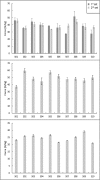Kinematics and Kinetics of Squats, Drop Jumps and Imitation Jumps of Ski Jumpers
- PMID: 26418370
- PMCID: PMC4780482
- DOI: 10.1519/JSC.0000000000001166
Kinematics and Kinetics of Squats, Drop Jumps and Imitation Jumps of Ski Jumpers
Abstract
Squats, drop jumps, and imitation jumps are commonly used training exercises in ski jumping to enhance maximum force, explosive force, and sport-specific skills. The purpose of this study was to evaluate the kinetics and kinematics of training exercises in ski jumping and to find objective parameters in training exercises that most correlate with the competition performance of ski jumpers. To this end, barbell squats, drop jumps, and imitation jumps were measured in a laboratory environment for 10 elite ski jumpers. Force and motion data were captured, and the influence of maximum vertical force, force difference, vertical take-off velocity, knee moments, knee joint power, and a knee valgus/varus index was evaluated and correlated with their season jump performance. The results indicate that, especially for the imitation jumps, a good correlation exists between the vertical take-off velocity and the personal jump performance on the hill (R = 0.718). Importantly, however, the more the athletes tended toward a valgus knee alignment during the measured movements, the worse their performance (R = 0.729 imitation jumps; R = 0.685 squats). Although an evaluation of the athletes' lower limb alignment during competitive jumping on the hill is still required, these preliminary data suggest that performance training should additionally concentrate on improving knee alignment to increase ski jumping performance.
Figures
References
-
- Abelbeck KG. Biomechanical model and evaluation of a linear motion squat type exercise. J Strength Cond Res 16: 516–524, 2002. - PubMed
-
- Bachmann C, Gerber H, Stacoff A. Measurement systems, measurements methods and examples for the instrumented gait analysis. Schweizerische Z für Sportmedizin Sporttraumatologie 56: 29–34, 2008.
-
- Blackwood B, Graham JF. Drop jumps. Strength Cond J 27: 57–59, 2005.
-
- Bobbert MF. Drop jumping as a training method for jumping ability. Sports Med 9: 7–22, 1990. - PubMed
-
- Bobbert MF, Huijing PA, van Ingen Schenau G. Drop jumping. I. The influence of jumping technique on the biomechanics of jumping. Med Sci Sports Exerc 19: 332–338, 1987. - PubMed
MeSH terms
LinkOut - more resources
Full Text Sources
Other Literature Sources



